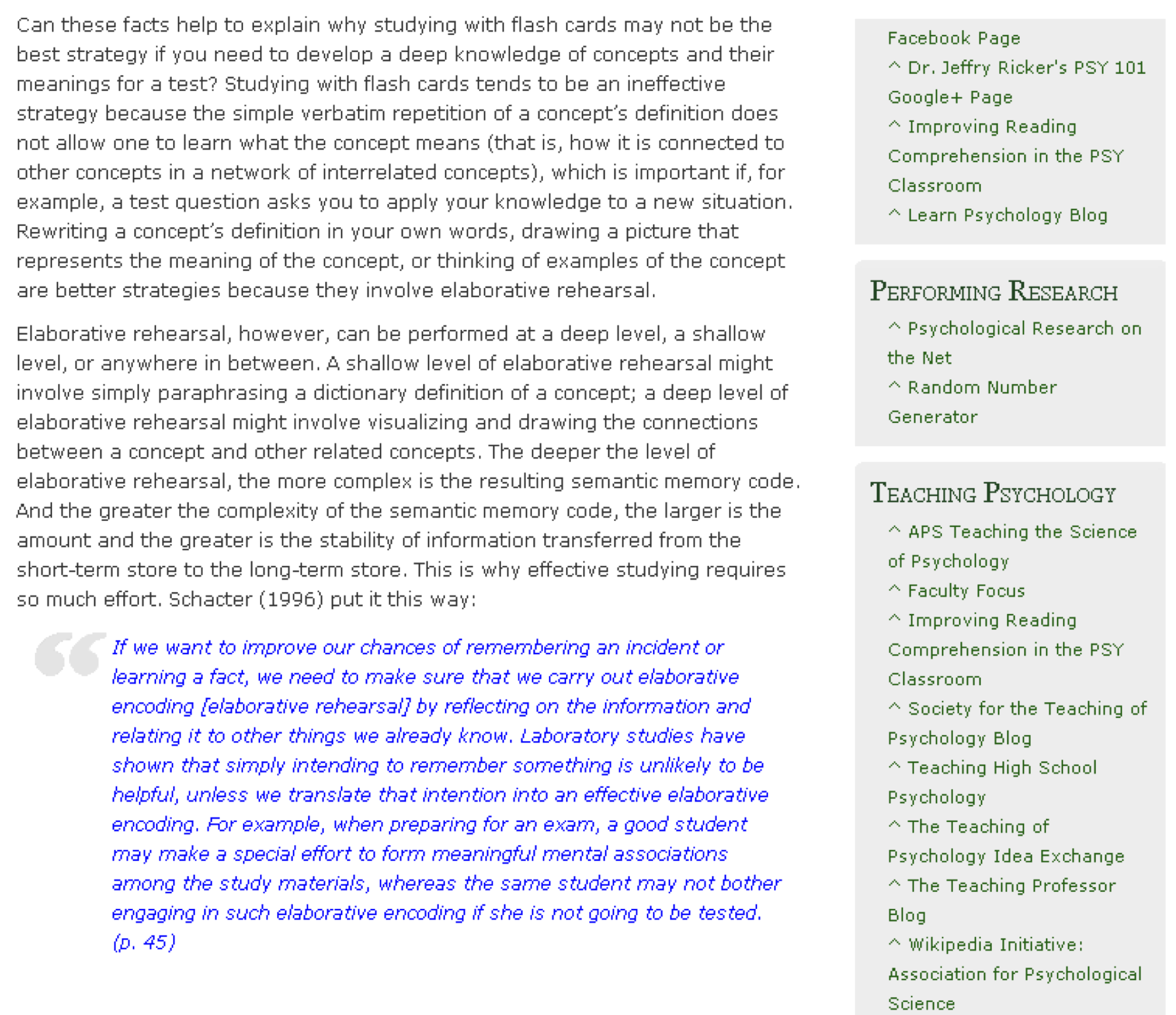5.4.1: Elaboration strategey notebook review
( \newcommand{\kernel}{\mathrm{null}\,}\)
Learning Objectives
- Review of notebooks, annotation/elaboration practice, and Cornell notes
-
What does “elaboration” mean in the reading and learning process? How can you use elaboration practices to master academic content?
-
Why is thorough annotation and close reading important when learning from academic texts?
-
Peer annotation review exercise.
-
Reader’s Notebook: Write a multi-paragraph reflection regarding your feedback from the homework and notebook rubrics. Discuss how you did and how you plan to approach similar work in the future.
What is Elaborative Rehearsal?
-
defining concepts in one’s own words;
-
thinking up one’s own examples for concepts;
-
relating information to oneself;
-
drawing illustrations that show the interconnections among related concepts;
-
answering“study questions” about the concepts;
-
asking questions about the concepts (and trying to answer the questions themselves, if possible).
Effective College Study Strategies
-
Background knowledge, general reading ability, and motivation are key factors in reading comprehension.
-
Highlighting isn’t enough – except with very short texts.
-
In order for your note taking to be an effective practice for you, your notes must be generative; that is, you must paraphrase, summarize, visualize, add content, and ask “how” and “why” questions in your notes.
-
Effective annotation is a key college reading skill; annotation must be generative to be effective.
-
Collaborative text review, discussing/comparing notes, and especially, cooperative questioning activities with others will help improve your performance.
Perform some pre-reading strategies to create schema(a mental scaffold) for your reading.
- Survey the section – that is, skim the title, note any introductory materials (such as videos, audio files, web links), headings, sub-headings, summary boxes, bolded terms, and study questions.
-
Again, consider any background knowledge you bring to the section.
Third, decide on a reading strategy that involves generative note taking or annotation.
-
Informal notes – randomly organized lists, bullet points, drawings, etc.
-
Outline Notes
-
Mind Mapping
-
Cornell Notes
-
Text Annotation
-
An especially effective reading strategy is to combine two methods such as annotation and Cornell notes.
Reflection: How to Annotate Text
Which are you using regularly? Which are you developing?
-
Writing brief paraphrased summaries in text margins
-
Selectively underlining/highlighting of key words and phrases – labeling, noting, summarizing them in the margins
-
Enumerating or labeling related multiple ideas, reasons, facts (i.e. characteristics; cause-effect relationships)
-
Noting examples in the margins
-
Making charts, graphs, other visual representations of text in margins
-
Noting confusion with a question mark
-
Marking text for possible test questions (Use your study guide questions when you have them.)
-
Annotating for specific purposes: taking notes in textbooks, additional readings, rhetorical structure, etc.
Defining Elaboration- Denotation
-
Denotation (n) – the explicit or direct meaning of the a word or set of words
-
elaboration (n) – the act or instance of adding detail, information, and extending to expand meaning
-
to elaborate (v) – to work out carefully; to develop to perfection



Effective College Study Strategies
-
Background knowledge, general reading ability, and motivation are key factors in reading comprehension.
-
Highlighting isn’t enough – exceptwith very short texts.
-
In order for your note taking to be an effective practice for you, your notes must be generative; that is, you must paraphrase, summarize, visualize, add content, and ask “how” and “why” questions in your notes.
-
Effectiveannotationis a key college reading skill; annotation must be generativeto be effective.
-
Collaborative text review, discussing/comparing notes, and especially, cooperative questioning activities with others will help improve your performance.
“In Your Own Words…”
-
Review your annotations and Cornell Notes.
-
Relate the information to your background knowledge.
-
CREATEnew sentences using the key ideas from the readings.
-
WRITEa summary of the information learned.
-
THIS TAKES TIME. Give yourself time to reflect, connect, and consider the gravity of the information acquired.
Peer Review Exercise
-
Take out your annotated chapter due today, “Emerging Adulthood.”
-
In groups of three, review and assign points based on the rubric provided.
-
Each peer gives you the points he/she thinks you have earned.
-
Each peer makes one suggestion or comment regarding your annotations.
-
YOU make one goal statement about how you will improve or build upon your current annotation practice.
Reader’s Notebook Exit Slip
In Your Reader’s Notebook:
- Write a multi-paragraphreflection regarding your feedback from the homework and notebook rubrics. Discuss your performance and how you plan to approach similar work in the future in order to meet with the greatest success possible in the course.

